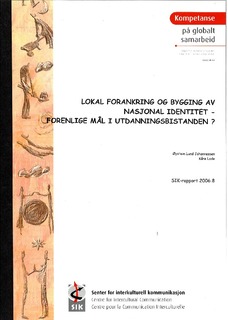| dc.contributor.author | Johannessen, Øystein Lund | |
| dc.contributor.author | Lode, Kåre | |
| dc.date.accessioned | 2008-05-09T08:39:11Z | |
| dc.date.issued | 2006 | |
| dc.identifier.isbn | 82-7721-108-2 | |
| dc.identifier.issn | 1500-1474 | |
| dc.identifier.uri | http://hdl.handle.net/11250/162270 | |
| dc.description.abstract | In this report the authors argue that development aid in the educational sector will have to take into account both the local socio-cultural context and the national policy of education in the recipient country, in order to reach its main goals. Consequently we think that a cultural analytic perspective on development in the educational sector is important and it must be applied on all relevant levels. It must include a critical view of the main goals of development aid compared with the main goals that are stated in the national legislation on education in the recipient country. This could be considered as a necessary expression of a top-down and an outside perspective on the development aid in the educational sector. However, at the same time we need to compare the main development goals with local culture and traditions and different local power structures. Finally, these main goals must be compared with the socio-economic situation and the strategy of adaptation of each household, in which education for one or more children is one important element. This bottom-up perspective on development aid in the educational sector, must be regarded as equally important as the top-down education policy perspective. These main perspectives need to be allowed to meet and confront each other in open discussions and negotiations on arenas where one strives for equality, openness and sober-mindedness.
A good result depends on openness to realise and accept both the complexity and internal tensions between the various goals of the development aid to the educational sector, and the courage to address the asymmetrical roles of donor and recipient in relation to power and to reduce the consequences of this fact. Finally it needs a sober-mindedness in the calculations as to what is needed in terms of presence over time and total use of resources in order to achieve a lasting change in this very important sector of development aid.
Local communities would often put a strong emphasis on a cultural perspective that does not alienate the children and on a possible vocational aspect of the school in order to improve the family’s income situation whereas national authorities may prefer to under-communicate differences in their nation building efforts. However - maybe none of these societal levels will pay attention to equal possibilities for boys and girls in relation to education, something that is a very important concern for many donors. International co-operating partners from the South and the North therefore must be prepared for negotiations as well as compromises in order to reach acceptable agreements and viable co-operative projects in the future. | en |
| dc.format.extent | 217743 bytes | |
| dc.format.extent | 862649 bytes | |
| dc.format.mimetype | application/pdf | |
| dc.format.mimetype | application/pdf | |
| dc.language.iso | nor | en |
| dc.publisher | Misjonshøgskolens forlag | en |
| dc.relation.ispartofseries | SIK-rapport | en |
| dc.relation.ispartofseries | 2006:8 | en |
| dc.subject | education policy | en |
| dc.subject | vocational training | en |
| dc.subject | nation building | en |
| dc.subject | gender policy | en |
| dc.subject | development | en |
| dc.title | Lokal forankring og bygging av nasjonal identitet - forenlige mål i utdanningsbistanden? | en |
| dc.type | Research report | en |
| dc.subject.nsi | VDP::Social science: 200::Political science and organizational theory: 240 | en |
